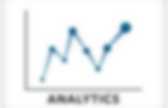

Bounce Rates in Higher Ed: The Good, the Bad and the Ugly. Date posted: March 11, 2013 When marketing managers begin working with Google Analytics to learn more about their website’s effectiveness, bounce rate is one of the first metrics they are exposed to.

Google Analytics certainly highlights it, putting it up front on almost every report. As they explore their site statistics and get comfortable with visits, visitors and duration of visits, they inevitably turn to bounce rate and say ”OK, I now understand that we are "bouncing" a lot of people off our site, and that’s a bad thing. So what would a reasonable bounce rate be for my site and how do I get it there? An experienced digital marketer, with a bit of time on their hands, will answer "it depends", and then go on to explain why it is important to understand why bounce rate is so variable on typical higher ed web pages (and in fact, in most industries). What is a Bounce? What’s a Typical Bounce Rate? So what’s a typical bounce rates for a website? Using Analytics Tools to Understand Better Market Segments in Higher Education. Date posted: May 11, 2012 Good marketing is all about segmentation.

If you truly understand your market and communicate effectively with them you will be successful in whatever your goals or “conversion events” might be. The higher ed marketplace is no different in this respect, it is just really complicated by the wide range of programs, approaches and types of people it serves. This post provides a few organizing concepts and examples to try and help make it a bit simpler for higher education marketers to understand their digital market segments and improve their overall effectiveness (and results!) Phil Taza presents Cross Domain Tracking 101, at the Feb 5, 2014 Higher Ed Analytics Conference. Google Analytics Content Groups for Higher Ed Marketing. Date posted: February 10, 2014 Higher ed websites have complicated architectures designed to organize and optimize information about lots of different topics for lots of different audiences.
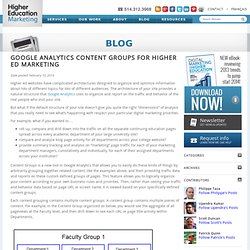
The architecture of your site provides a natural structure that Google Analytics uses to organize and report on the traffic and behavior of the real people who visit your site. But what if the default structure of your site doesn't give you quite the right “dimensions” of analysis that you really need to see what’s happening with respect your particular digital marketing priorities. For example, what if you wanted to … roll up, compare and drill down into the traffic on all the separate continuing education pages spread across every academic department of your large university site?
Each content grouping contains multiple content groups. Content Groupings are created in Admin/ Content Groupings. The Impact of “Keyword Not Provided” in Higher Ed Marketing. Date posted: October 8, 2013 If you have a role in digital marketing at your institution you’ve probably heard that Google is rolling out a very significant change to Google Analytics, (GA) that seriously limits your previous capabilities to track keyword search data and trends on your college’s or university’s website.

Google Analytics' Social Media Hub. Date posted: December 20, 2011 We've often discussed the increasing importance of both Google Analytics and a comprehensive social media plan (that incorporates your content and marketing messages across a number of different platforms), so it's nice to see that Google Analytics has now made it easier to combine the two.
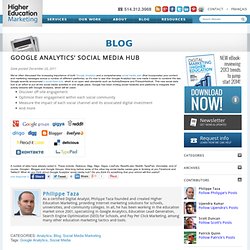
Google recently announced a social data hub, which is on open web standards such as ActivityStreams and PubsubHubbub. This new social data hub is an effort to put all the social media activities in one single place. Why Every Higher Ed Marketer Needs to Understand and Use Cross Domain Tracking. Date posted: November 4, 2013 Higher education web ecosystems are generally pretty complicated and include multiple domains, sub-domains, microsites, payment gateways, CRM systems and external promotions, etc.
To understand the visitor traffic patterns across all these sites and the effectiveness of your related marketing efforts you need to be able to track visitors through this labyrinth and determine which content and pathways are leading the most visitors to the most conversions that meet your business goals. Three Aspects of Managing Web Analytics for Higher Ed Marketing. Date posted: August 17, 2012 Managing analytics for a higher ed institution can get pretty complicated.

It takes a range of skills sets, of varying levels of sophistication to do it well. In a recent blog post, Avinesh Kaushik, Google's Digital Marketing Evangelist, breaks down web analytics into its three component parts and then discusses some of the individual skills sets and capabilities that individuals require to manage these areas well. In higher education marketing these three aspects bring some specific challenges that I thought would be worth pointing out. 1) Data Capture This first aspect involves the configuration of analytics so that you can accurately capture data on the traffic patterns and behavior of your visitors.
In fact they are generally very complicated with multiple domains, need multiple profiles, have mobile sites, flash, events, have complicated goals and registration funnels, link to CRMs, etc. Using Analytics Tools to Understand Better Market Segments in Higher Education. Conducting cohort analysis with Google Analytics. Date posted: December 11, 2013 Cohort analysis, sometimes referred to as longitudinal analysis, focuses on the behavior of cohort groups (a group of people who share similar characteristics or behavior) within a predefined timespan.
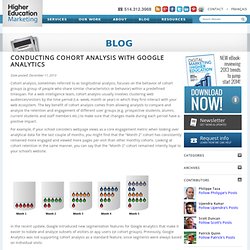
For a web intelligence team, cohort analysis usually involves clustering web audiences/visitors by the time period (i.e. week, month or year) in which they first interact with your web ecosystem. The key benefit of cohort analysis comes from allowing analysts to compare and analyze the retention and engagement of different user groups (e.g. prospective students, alumni, current students and staff members etc.) to make sure that changes made during each period have a positive impact. Analytics-Driven Marketing Defined for Higher Ed. Date posted: December 19, 2012 In a recent discussion about student recruitment with a senior college marketer, I made the remark that our company’s approach to digital marketing was “analytics-driven“.

His pursed lips and annoyed stare told me that what he heard was unhelpful techno-speak and that it was not appreciated. He responded very academically, “That sounds nice, but what does that mean?” 3 Other Ways to Get Visitor Keyword Info, Now That It’s “Not Provided” in Google Analytics. Date posted: October 18, 2013 In last week's post we discussed the nature and implications of the fact that Google Analytics is no longer providing detailed keyword data about visitors to your websites.
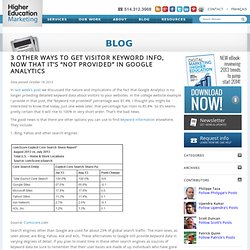
In the college website example I provide in that post, the “keyword not provided” percentage was 81.4%. I thought you might be interested to know that today, just one week later, that percentage has risen to 85.8%. Higher Ed Search Analytics are Simplified with New Google Adwords Report. Date posted: September 16, 2013 It just got a lot easier to track, analyze and understand the relationship between PPC ads and organic listings on Google’s search engine results pages (SERPs). Google Adwords’ new report, called the “Paid and Organic ” report, provides comparative analysis of visitor traffic and click through behavior on Google search engine results pages for the following three scenarios: The New Google Analytics Acquistion Report: A Primer for Higher Ed Marketers.
Date posted: October 25, 2013 If you are a typical college or university marketer who checks in once and a while with Google Analytics (GA) to see how your website and related marketing are doing it’s really hard to keep up on all of the changes that Google is implementing. Even more importantly, it’s hard to interpret what these changes mean with respect to how you should use analytics to optimally track and manage your online activities. Google has made a recent, significant change to what was known as Traffic Sources, that I think is a really positive step in the direction of helping marketers gain a better macro understanding of visitor activity on their sites.
So here’s a quick primer of what they've done with the new Acquisition report, along with a few observations on what it might mean to you. Bringing Big Data to your School’s Analytics. Date posted: September 3, 2013 Every day, we create multiple terabytes of data. It comes from every dimension: Social media, email communication, digital graphics, online transaction and many more. This data is really big and getting bigger and bigger! Like any other niche, the education system produces a tremendous amount of data as well.
Optimisation de site web. Date posted: August 9, 2011 Quels genres de personnes visitent votre site? Quelles sont leurs principales caractéristiques? Quelles actions voulez-vous que vos visiteurs accomplissent sur votre site Internet? La phase initiale de toute initiative marketing basée sur des outils analytiques doit répondre à ces questions. Higher Education Marketing utilise un processus d’entrevues pour extraire ces informations et vous aider à mieux comprendre les caractéristiques de vos visiteurs. Cette information permettra de déterminer vos cycles de vie qui sont les différentes étapes de l’interaction de votre site Internet avec les publics cibles choisis (par ex. cherchez-vous à attirer des étudiants potentiels ou à conserver un lien avec vos anciens élèves?).
Les personas sont des personnes fictives créées pour représenter les différents types d’utilisateurs dans un groupe d’étudiants donné. 3 Essential Social Media Measurement Tools for Your School. Date posted: August 23, 2012 The return on investment (ROI) of social media initiatives is one of the current Holy Grails in higher ed. With a wide variety of marketing goals (increase lead generation and admissions, enhance retention and reputation, etc.) and what seems to be an infinity of metrics (comments, shared content, views, follow, etc.), it is virtually impossible to track the specific effect of all the social media initiatives going on at your school. So much so that some specialists are now questioning the very idea of a Social Media ROI in higher ed.
Digital Metrics Every School Should Measure. Date posted: July 31, 2013 So your school has set web ecosystem and has a digital marketing plan in place, but have you decided what the objectives for the entire web system are? Is this a lead generation tool or purely for institutional prestige? Have you identified your key performance metrics yet? Do you know whether your marketing efforts are really paying off or not? Establishing goals and setting benchmarks is the key to all initiatives, especially when your school begins to standardize all the marketing measurement across its leads channels and media partners.
Avoiding Common Google Analytics Mistakes. Date posted: May 23, 2011. Configure cross-domain tracking to enhance your College’s marketing measurability. Date posted: July 12, 2013 One of the greatest strengths of Google Analytics, besides its powerful reporting capabilities, is being able to go out of the box for most analytical scenarios. 5 Tips to Optimize Your Admissions Pages for Lead Generation. Date posted: July 5, 2013 No higher education institution would dispute that their website is an important asset for all their student marketing initiatives, but this is proving more critical every day. Tip of the week: How to Access Official Twitter Analytics. Date posted: June 26, 2013 If, like us, you were wondering if Twitter was ever going to release analytics, rejoice!
Chris Penn recently noticed a hidden gem that will very likely help you gain insight about what content your students share most on Twitter. Free analytics directly from Twitter. Analytics-Driven Marketing for Colleges and Universities. Universal Analytics: Implications in Higher Ed. The Wonderful World of Google Products. The Benefit to Linking Google Products. Date posted: March 25, 2011. Inside Google Analytics with HEM. Date posted: July 6, 2010. Google Analytics (Quietly) Adds Email Scheduling and PDF Reports. Tips on How to Develop Google Analytics Goals for your Higher Ed Website. Higher Education Marketing ROI Primer.
Marketing for Schools. Multi-attribution modeling: A way to enhance your school’s marketing measurability. Multi-Channel Attribution using Google Analytics. Education Marketing Analytics.